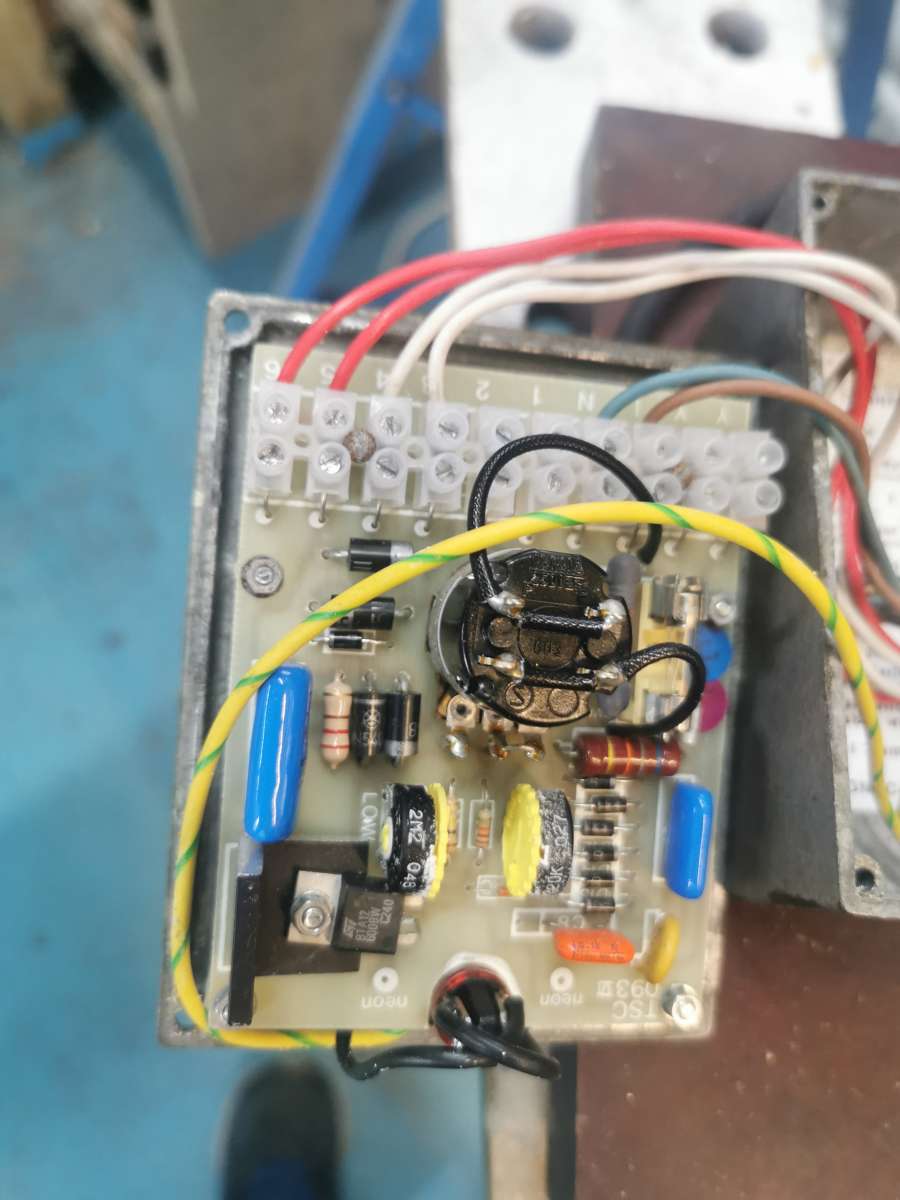On the face of it, the motor is reversible using peak3’s third diagram labelled “Series Wound 4 lead Reversing”, which (apart from the speed controller being one way only), is consistent with the second entry “Series Motor 1/4 H.P. (4 leads)” and the wires going into the terminal block.
Visual inspection suggests this is an elderly motor that’s been stored in the damp. Until proven otherwise, it’s a high-risk safety hazard, – electrocution and fire. Therefore approach with caution!!! The advice that follows isn’t foolproof, and assumes a reasonable understanding of electricity, the instruments necessary, and some experience debugging live circuits. Much easier and safer to do with previous experience, so my advice is not to attempt it if at all uncertain.
I would start by making sure the motor, controller and wiring were all thoroughly dry, perhaps by leaving it for a few days in a warm airing cupboard.
Then check the mains cable for damage. Ancient insulation perishes, cracks and crumbles so replace the mains lead if at all suspicious. (What’s visible in the picture looks OK but make sure.)
Strictly speaking the old mains plug is illegal because the L and N pins are solid brass creating a mild risk of a finger touching the live pin whilst the plug is being inserted. Enough children and small fingered adults were zapped to justify a design change.
With a multimeter confirm:
- the fuse in the plug is OK. (A 3A fuse should be fitted.)
- continuity between the plug’s earth pin and the controller box and the motor.
- no continuity between the plug’s live pin and the controller box and the motor.
- no continuity between the plug’s neutral pin and the controller box and the motor.
Put the motor and controller on a wooden bench, and set the speed control mid-way. Have a fire blanket or bucket of sand handy. If the floor is concrete, put down a rubber mat. (Damp concrete floors multiply the shock hazard.)
Plug the unit into a remote switched off Variac set to zero volts. Remote means the motor and controller are out of reach if the worst happens during the test. If any bad happens, unplug the power first, then deal with the emergency.
Power up the Variac, and whilst watching for smoke, sparks, smells or other bad behaviour, gradually increase the power up to 240Vac. If the controller and motor are working the motor should start spinning at some point as the volts increase. The variac protects the motor and electronics if there’s a fault. Don’t touch the device during this test. (A 60W filament light bulb can be substituted for a Variac, but requires more expertise.)
If the motor runs OK, after a few minutes, confirm with an electrician’s screwdriver that the motor and controller cases are not live.
Assuming all is well, check turning the speed control knob changes speed.
Let the motor run attended for at least 30 minutes, then disconnect power, and make sure the motor isn’t overheating.
If any of the tests fail, debugging the problem is more difficult.
Comments:
The speed controller looks clean apart from the pre-set pots covered in white efflorescence, which is typical of damp. They, and the front panel speed control pot, may need a squirt of switch cleaner to get them working, or they may have to be replaced. Damp is very bad for electronics and there may be corrosion on the other side of the board. Don’t panic if the electronics are entirely bust, the controller is an inexpensive easily replaced Triac type.
I think a double pole, double throw switch that swaps the armature windings over will reverse the motor. Ideally. the switch should have an OFF central position because going from forward to reverse whilst the motor is still turning is a common operator mistake, and expensive!
Whether or not the motor is suitable for moving a mill table is moot. As advertised, the motor spins at 4000 rpm which is far too fast to apply direct to a leadscrew. My guess is 30 rpm to 100rpm is needed. The electronic controller is unlikely to provide enough torque at that speed, so gearing down may be required. Try it and see, but my guess is a 4:1 or 5:1 reduction gear between the motor shaft and the leadscrew will be needed. I’ve not motorised my mill, so I hope someone who has will comment on the RPM needed and how best to deliver it. Getting this particular motor to work properly feels like hard work, even if it’s electrically sound.
Dave
 Michael Gilligan.
Michael Gilligan.









 h
h ere
ere




